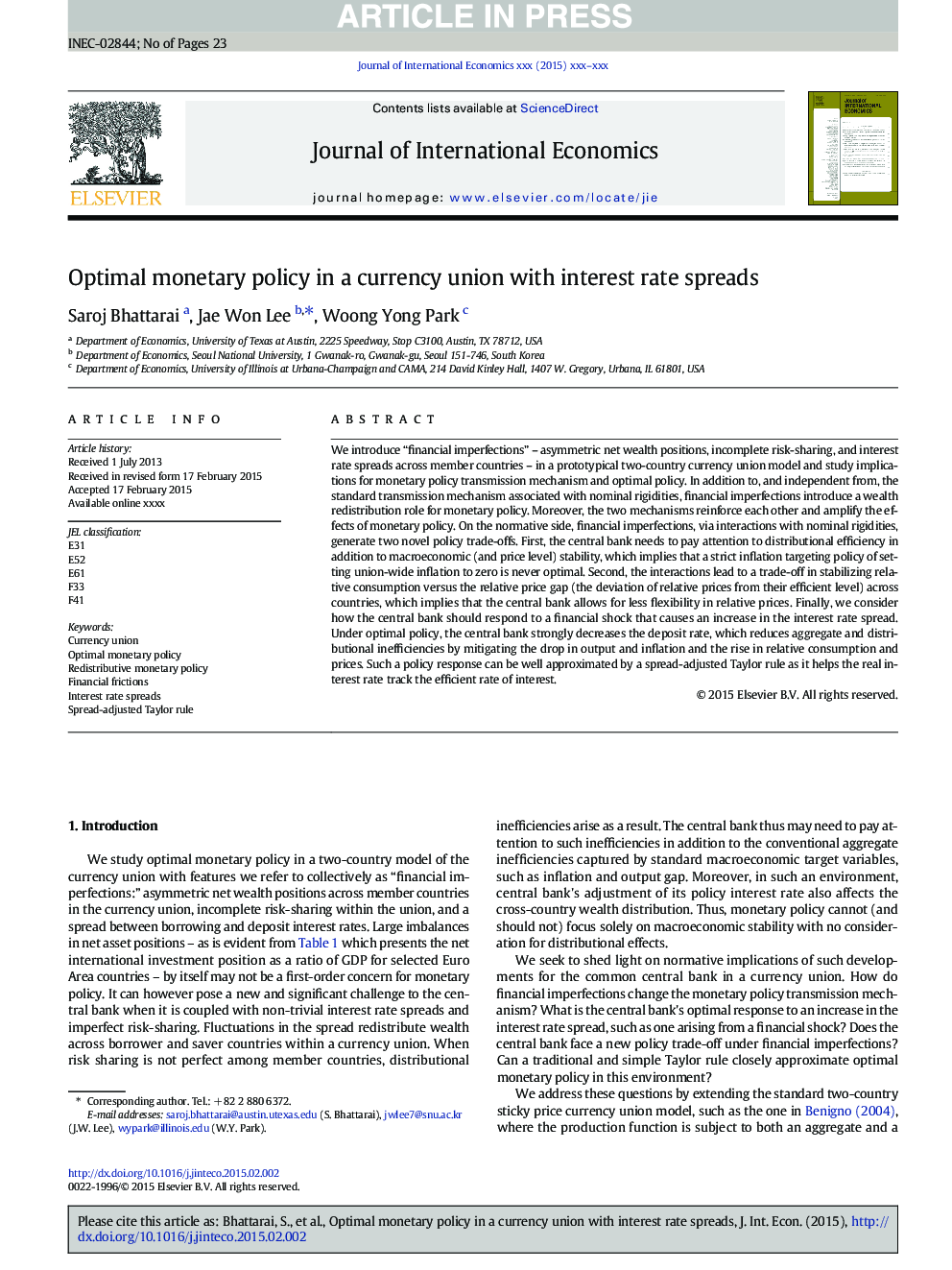| کد مقاله | کد نشریه | سال انتشار | مقاله انگلیسی | نسخه تمام متن |
|---|---|---|---|---|
| 962927 | 930206 | 2015 | 23 صفحه PDF | دانلود رایگان |
عنوان انگلیسی مقاله ISI
Optimal monetary policy in a currency union with interest rate spreads
ترجمه فارسی عنوان
سیاست پولی مطلوب در یک اتحادیه ارز با نرخ بهره
دانلود مقاله + سفارش ترجمه
دانلود مقاله ISI انگلیسی
رایگان برای ایرانیان
کلمات کلیدی
ترجمه چکیده
ما یک نقص فنی را معرفی میکنیم - موقعیت های ثروت خالص نامتقارن، تقسیم ناقص خطر و نرخ بهره در کشورهای عضو - در یک مدل اتحادیه ارزهای دو جانبه نمونه اولیه و مطالعاتی برای مکانیزم انتقال سیاست پولی و سیاست مطلوب. به علاوه و مستقل از مکانیزم انتقال استاندارد مرتبط با استحکام اسمی، ناهنجاری های مالی نقش بازخرید ثروت را برای سیاست پولی معرفی می کند. علاوه بر این، این دو مکانیسم یکدیگر را تقویت می کنند و تاثیرات سیاست پولی را تقویت می کنند. در سمت هنجاری، نقص های مالی، از طریق تعامل با سفتی اسمی، دو خط مشی جدید را ایجاد می کند. اولا، بانک مرکزی باید علاوه بر ثبات اقتصاد کلان (و قیمت)، علاوه بر ثبات بهره وری، به کارایی توزیعی توجه کند، که این بدان معنی است که سیاست محرک تورم با هدف تنظیم تورم اتحادیه جهانی به صفر مطلوب نیست. ثانیا، تعاملات منجر به تعادل در تثبیت مصرف نسبی نسبت به شکاف قیمت نسبی (انحراف قیمت نسبی از سطح کارآمد آنها) در بین کشورها، که این امر بیانگر آن است که بانک مرکزی امکان انعطاف کمتر در قیمت نسبی را فراهم می آورد. در نهایت، ما در نظر می گیریم که چگونه بانک مرکزی باید به شوک مالی پاسخ دهد که باعث افزایش نرخ بهره می شود. تحت سیاست مطلوب، بانک مرکزی نرخ سپرده را به میزان قابل توجهی کاهش می دهد، که موجب کاهش ناکارآمدی مجموع و توزیع شده از طریق کاهش ریسک تولید و تورم و افزایش مصرف نسبی و قیمت ها می شود. چنین واکنش سیاستی می تواند به خوبی توسط قوانین تیلور تعدیل شده گسترش یابد؛ زیرا این امر به نرخ بهره واقعی کمک می کند تا نرخ کارآمد بهره را ردیابی کند.
موضوعات مرتبط
علوم انسانی و اجتماعی
اقتصاد، اقتصادسنجی و امور مالی
اقتصاد و اقتصادسنجی
چکیده انگلیسی
We introduce “financial imperfections” - asymmetric net wealth positions, incomplete risk-sharing, and interest rate spreads across member countries - in a prototypical two-country currency union model and study implications for monetary policy transmission mechanism and optimal policy. In addition to, and independent from, the standard transmission mechanism associated with nominal rigidities, financial imperfections introduce a wealth redistribution role for monetary policy. Moreover, the two mechanisms reinforce each other and amplify the effects of monetary policy. On the normative side, financial imperfections, via interactions with nominal rigidities, generate two novel policy trade-offs. First, the central bank needs to pay attention to distributional efficiency in addition to macroeconomic (and price level) stability, which implies that a strict inflation targeting policy of setting union-wide inflation to zero is never optimal. Second, the interactions lead to a trade-off in stabilizing relative consumption versus the relative price gap (the deviation of relative prices from their efficient level) across countries, which implies that the central bank allows for less flexibility in relative prices. Finally, we consider how the central bank should respond to a financial shock that causes an increase in the interest rate spread. Under optimal policy, the central bank strongly decreases the deposit rate, which reduces aggregate and distributional inefficiencies by mitigating the drop in output and inflation and the rise in relative consumption and prices. Such a policy response can be well approximated by a spread-adjusted Taylor rule as it helps the real interest rate track the efficient rate of interest.
ناشر
Database: Elsevier - ScienceDirect (ساینس دایرکت)
Journal: Journal of International Economics - Volume 96, Issue 2, July 2015, Pages 375-397
Journal: Journal of International Economics - Volume 96, Issue 2, July 2015, Pages 375-397
نویسندگان
Saroj Bhattarai, Jae Won Lee, Woong Yong Park,
